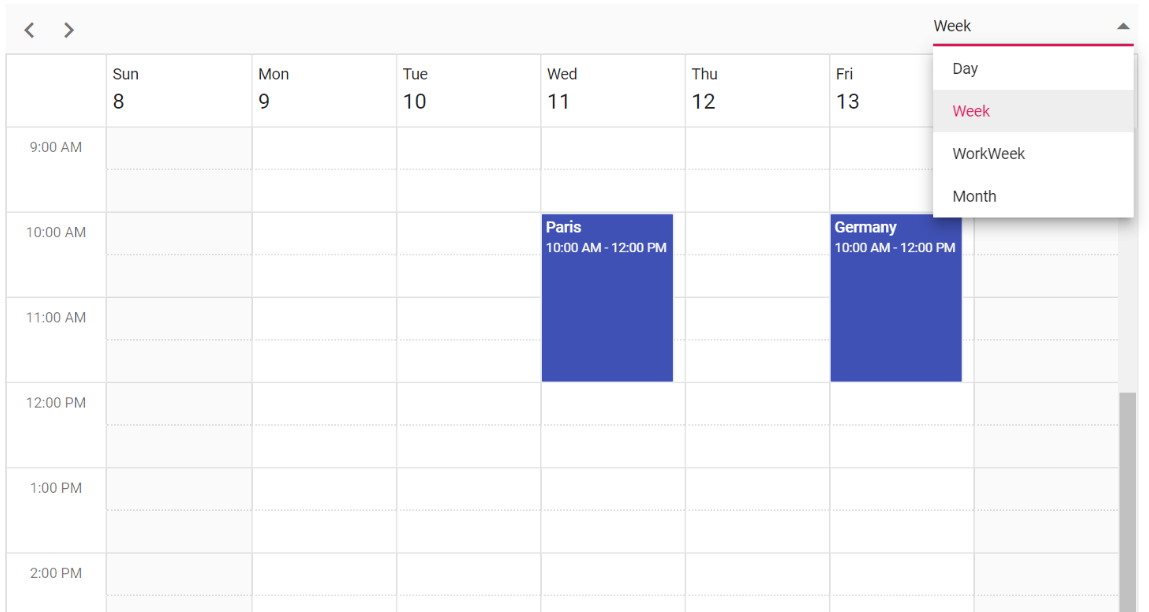Custom Header in Blazor Scheduler Component
29 Nov 20245 minutes to read
The Scheduler header bar can be hidden by setting false to ShowHeaderBar and use Syncfusion® Toolbar control to customize our own header. In the following code example, the Scheduler views can be changed by using the Dropdowns available in the custom Header.
@using Syncfusion.Blazor.Schedule
@using Syncfusion.Blazor.Navigations
@using Syncfusion.Blazor.DropDowns
<SfToolbar>
<ToolbarItems>
<ToolbarItem Align="ItemAlign.Left" PrefixIcon="previous" OnClick="@Clicked" TooltipText="Previous"></ToolbarItem>
<ToolbarItem Align="ItemAlign.Left" PrefixIcon="next" OnClick="@Clicked" TooltipText="Next"></ToolbarItem>
<ToolbarItem Type="ItemType.Separator"></ToolbarItem>
<ToolbarItem Type="ItemType.Input" Align="ItemAlign.Right">
<Template>
<SfDropDownList TItem="Views" TValue="string" ID="Views" DataSource="@ViewsList" Width="120" @bind-Index="@index">
<DropDownListEvents TItem="Views" TValue="string" ValueChange="OnValueChange"></DropDownListEvents>
<DropDownListFieldSettings Value="Text"></DropDownListFieldSettings>
</SfDropDownList>
</Template>
</ToolbarItem>
</ToolbarItems>
</SfToolbar>
<SfSchedule @bind-SelectedDate="@DateValue" TValue="AppointmentData" @bind-CurrentView="@MyView" Height="650px" ShowHeaderBar="false">
<ScheduleEventSettings DataSource="@DataSource"></ScheduleEventSettings>
<ScheduleViews>
<ScheduleView Option="View.Day"></ScheduleView>
<ScheduleView Option="View.Week"></ScheduleView>
<ScheduleView Option="View.WorkWeek"></ScheduleView>
<ScheduleView Option="View.Month"></ScheduleView>
<ScheduleView Option="View.Agenda"></ScheduleView>
</ScheduleViews>
</SfSchedule>
<style>
.previous:before {
content: '\e937';
}
.next:before {
content: '\e956'
}
</style>
@code{
public DateTime DateValue { get; set; } = new DateTime(2020, 2, 11);
public View MyView = View.Week;
private int? index = 1;
public void Clicked(ClickEventArgs args)
{
int addDay = 7;
if (MyView == View.Day) addDay = 1;
if (MyView == View.Week) addDay = 7;
if (MyView == View.WorkWeek) addDay = 5;
if (MyView == View.Month) addDay = 30;
if (args.Item.PrefixIcon == "previous")
{
DateValue = DateValue.AddDays(-addDay);
}
if (args.Item.PrefixIcon == "next")
{
DateValue = DateValue.AddDays(addDay);
}
}
public void OnValueChange(ChangeEventArgs<string, Views> args)
{
this.MyView = (View)Enum.Parse(typeof(View), args.Value);
}
public class Views
{
public string ID { get; set; }
public string Text { get; set; }
}
List<Views> ViewsList = new List<Views> {
new Views() { ID= "1", Text= "Day" },
new Views() { ID= "2", Text= "Week" },
new Views() { ID= "3", Text= "WorkWeek" },
new Views() { ID= "4", Text= "Month" }
};
List<AppointmentData> DataSource = new List<AppointmentData>
{
new AppointmentData { Id = 1, Subject = "Paris", StartTime = new DateTime(2020, 2, 11, 10, 0, 0) , EndTime = new DateTime(2020, 2, 11, 12, 0, 0) },
new AppointmentData { Id = 2, Subject = "Germany", StartTime = new DateTime(2020, 2, 13, 10, 0, 0) , EndTime = new DateTime(2020, 2, 13, 12, 0, 0) }
};
public class AppointmentData
{
public int Id { get; set; }
public string Subject { get; set; }
public string Location { get; set; }
public DateTime StartTime { get; set; }
public DateTime EndTime { get; set; }
public string Description { get; set; }
public bool IsAllDay { get; set; }
public string RecurrenceRule { get; set; }
public string RecurrenceException { get; set; }
public Nullable<int> RecurrenceID { get; set; }
}
}